Do New Urbanization Policies Promote Sustainable Urbanization? Evidence from China’s Urban Agglomerations
Abstract
1. Introduction
2. Literature Review
2.1. Studies on Sustainable Urbanization
2.2. Studies on Urban Agglomeration
3. Study Area and Methods
3.1. Study Area
3.2. Data Source
3.3. Methods
3.3.1. The Elastic Coefficient Method for Assessing Sustainable Urbanization
3.3.2. Measurement of Urbanization Rate
3.3.3. Measurement of Urbanization Sustainability
- (a)
- Indicator System
- (b) Aggregation
4. Results
4.1. Urbanization Rate Change in China’s Urban Agglomerations
4.2. The Change in Urbanization Sustainability in Chinese Urban Agglomerations
4.3. Dynamic Sustainable Urbanization of Chinese Urban Agglomerations from 2010 to 2021
5. Discussion
5.1. Dynamics of Sustainable Urbanization Status
5.2. Change in City Size and Sustainable Urbanization Status
5.3. Urbanization Growth Rate and Sustainable Urbanization Status
5.4. The New Urbanization Policy and Sustainable Urbanization of Urban Agglomerations
6. Conclusions
Author Contributions
Funding
Data Availability Statement
Conflicts of Interest
References
- United Nations, Department of Economic and Social Affairs, Population Division. World Urbanization Prospects: The 2018 Revision (ST/ESA/SER.A/420); United Nations: New York, NY, USA, 2019. [Google Scholar]
- Bloom, D.E.; Canning, D.; Fink, G. Urbanization and the Wealth of Nations. Science 2008, 319, 5864. [Google Scholar] [CrossRef] [PubMed]
- Glaeser, E. Cities, Productivity, and Quality of Life. Science 2011, 333, 6042. [Google Scholar] [CrossRef] [PubMed]
- Ochoa, J.J.; Tan, Y.T.; Qian, Q.K.; Shen, L.Y.; Moreno, E.L. Learning from best practices in sustainable urbanization. Habitat Int. 2018, 78, 83–95. [Google Scholar] [CrossRef]
- Ahmad, N.; Raid, M.; Alzyadat, J.; Alhawal, H. Impact of urbanization and income inequality on life expectancy of male and female in South Asian countries: A moderating role of health expenditures. Humanit. Soc. Sci. Commun. 2023, 10, 552. [Google Scholar] [CrossRef]
- Fang, C.L.; Bao, C.; Ma, H.T. China’s Urban Agglomeration Development Report in 2016; People’s Publishing House: Beijing, China, 2016. [Google Scholar]
- Kalnay, E.; Cai, M. Impact of urbanization and land-use change on climate. Nature 2003, 423, 528–531. [Google Scholar] [CrossRef]
- Olivier, T.; Thébault, E.; Elias, M.; Fontaine, B.; Fontaine, C. Urbanization and agricultural intensification destabilize animal communities differently than diversity loss. Nat. Commun. 2020, 11, 2686. [Google Scholar] [CrossRef] [PubMed]
- Guo, J.H.; Yu, Z.Q.; Ma, Z.H.; Xu, D.Y.; Cao, S.X. What factors have driven urbanization in China? Environ. Dev. Sustain. 2022, 24, 6508–6526. [Google Scholar] [CrossRef]
- Lu, D.D.; Chen, M.X. Several viewpoints on the background of compiling the “National New Urbanization Planning (2014–2020)”. Acta Geogr. Sin. 2015, 70, 179–185. (In Chinese) [Google Scholar]
- Fang, C.L.; Ma, H.T. New City District Development and Intensive Land Use in the Context of New-type Urbanization. China Land Sci. 2013, 27, 4–9. (In Chinese) [Google Scholar]
- Chen, M.X.; Gong, Y.H.; Lu, D.D.; Ye, C. Build a people-oriented urbanization: China’s new-type urbanization dream and Anhui model. Land Use Policy 2019, 80, 1–9. [Google Scholar] [CrossRef]
- Chu, Y.W. China’s new urbanization plan: Progress and structural constraints. Cities 2020, 103, 102736. [Google Scholar] [CrossRef]
- Bai, X.M.; Shi, P.J.; Liu, Y.S. Society: Realizing China’s urban dream. Nature 2014, 509, 158–160. [Google Scholar] [CrossRef] [PubMed]
- Chen, M.X.; Liu, W.D.; Lu, D.D.; Chen, H.; Ye, C. Progress of China’s new-type urbanization construction since 2014: A preliminary assessment. Cities 2018, 78, 180–193. [Google Scholar] [CrossRef]
- Yu, B.B. Ecological effects of new-type urbanization in China. Renew. Sustain. Energy Rev. 2021, 135, 110239. [Google Scholar] [CrossRef]
- Xu, C.; Wang, S.X.; Zhou, Y.; Wang, L.T.; Liu, W.L. A Comprehensive Quantitative Evaluation of New Sustainable Urbanization Level in 20 Chinese Urban Agglomerations. Sustainability 2016, 8, 91. [Google Scholar] [CrossRef]
- Yang, Y.; Huang, C.; He, C.Y.; Huang, Q.X. The Spatiotemporal Dynamics of New-Type Urbanization Comprehensive Level in Shandong Peninsula Urban Agglomeration. Econ. Geogr. 2017, 37, 77–85. (In Chinese) [Google Scholar]
- UN-Habitat/DFID. Sustainable Urbanisation: Achieving Agenda 21; UN-Habitat/DFID: Nairobi, Kenya, 2002. [Google Scholar]
- Fang, C.L. Important Progress and Prospects of China’s Urbanization and Urban Agglomeration in the Past 40 Years of Reform and Opening-Up. Econ. Geogr. 2018, 38, 1–9. (In Chinese) [Google Scholar]
- Fang, C.L.; Cui, X.G.; Li, G.D.; Bao, C.; Wang, Z.B.; Ma, H.T.; Sun, S.; Liu, H.M.; Luo, K.; Ren, Y.F. Modeling regional sustainable development scenarios using the Urbanization and Eco-environment Coupler: Case study of BeijingTianjin-Hebei urban agglomeration, China. Sci. Total Environ. 2019, 689, 820–830. [Google Scholar] [CrossRef]
- Pivo, G. Toward sustainable urbanization on Mainstreet Cascadia. Cities 1996, 13, 339–354. [Google Scholar] [CrossRef]
- Drakakis-Smith, D.; Dixon, C. Sustainable urbanization in Vietnam. Geoforum 1997, 28, 21–38. [Google Scholar] [CrossRef]
- UN-Habitat/DFID. World Cities Report 2020: The Value of Sustainable Urbanization. 2020. Available online: https://www.citiesalliance.org/newsroom/news/urban-news/world-cities-report-2020-value-sustainable-urbanization (accessed on 20 August 2023).
- Rasoolimanesh, S.M.; Badarulzaman, N.; Jaafar, M. City Development Strategies (CDS) and Sustainable Urbanization in Developing World. Procedia-Soc. Behav. Sci. 2012, 36, 623–631. [Google Scholar] [CrossRef]
- Shen, L.Y.; Peng, Y.; Zhang, X.L.; Wu, Y.Z. An alternative model for evaluating sustainable urbanization. Cities 2012, 29, 32–39. [Google Scholar] [CrossRef]
- Zhang, X.L. Sustainable urbanization: A bi-dimensional matrix model. J. Clean. Prod. 2016, 134, 425–433. [Google Scholar] [CrossRef]
- Shen, L.Y.; Shuai, C.Y.; Jiao, L.D.; Tan, Y.T.; Song, X.S. Dynamic sustainability performance during urbanization process between BRICS countries. Habitat Int. 2017, 60, 19–33. [Google Scholar] [CrossRef]
- Fang, X.; Shi, X.Y.; Phillips, T.K.; Du, P.; Gao, W.J. The coupling coordinated development of urban environment towards sustainable urbanization: An empirical study of Shandong Peninsula, China. Ecol. Indic. 2021, 129, 107864. [Google Scholar] [CrossRef]
- Cui, X.G.; Fang, C.L.; Liu, H.M.; Liu, X.F. Assessing sustainability of urbanization by a coordinated development index for an Urbanization-Resources-Environment complex system: A case study of Jing-Jin-Ji region, China. Ecol. Indic. 2019, 96, 383–391. [Google Scholar] [CrossRef]
- Kovács, Z.; Farkas, J.Z.; Szigeti, C.; Harangozó, G. Assessing the sustainability of urbanization at the sub-national level: The Ecological Footprint and Biocapacity accounts of the Budapest Metropolitan Region, Hungary. Sustain. Cities Soc. 2022, 84, 104022. [Google Scholar] [CrossRef]
- Liu, S.W.; Zhang, P.Y.; Jiang, X.L.; Lo, K. Measuring sustainable urbanization in China: A case study of the coastal Liaoning area. Sustain. Sci. 2013, 8, 585–594. [Google Scholar] [CrossRef]
- Longato, D.; Cortinovis, C.; Balzan, M.; Geneletti, D. A method to prioritize and allocate nature-based solutions in urban areas based on ecosystem service demand. Landsc. Urban Plan. 2023, 235, 104743. [Google Scholar] [CrossRef]
- Hernández, R.C.; Camerin, F. Assessment of ecological capacity for urban planning and improving resilience in the European framework: An approach based on the Spanish case. Cuad. Investig. Geográfica 2023, 49, 119–142. [Google Scholar] [CrossRef]
- Verma, A.; Sudhira, H.S.; Sudhira, S.; King, R.; Dash, N. Sustainable urbanization using high speed rail (HSR) in Karnataka, India. Res. Transp. Econ. 2013, 38, 67–77. [Google Scholar] [CrossRef]
- Roy, M. Planning for sustainable urbanization in fast growing cities: Mitigation and adaptation issues addressed in Dhaka, Bangladesh. Habitat Int. 2009, 33, 276–286. [Google Scholar] [CrossRef]
- Xu, Q.R.; Zheng, X.Q.; Zheng, M.R. Do urban planning policies meet sustainable urbanization goals? A scenario-based study in Beijing, China. Sci. Total Environ. 2019, 670, 498–507. [Google Scholar] [CrossRef] [PubMed]
- Xiong, W.; Chen, B.; Wang, H.M.; Zhu, D.J. Public–private partnerships as a governance response to sustainable urbanization: Lessons from China. Habitat Int. 2020, 95, 102095. [Google Scholar] [CrossRef]
- Yang, C.Y.; Zhu, C.H.; Albitar, K. ESG ratings and green innovation: A U-shaped journey towards sustainable development. Bus. Strategy Environ. 2023. [Google Scholar] [CrossRef]
- Wu, J.W.; Yang, C.Y.; Chen, L. Examining the non-linear effects of monetary policy on carbon emissions. Energy Econ. 2024, 131, 107206. [Google Scholar] [CrossRef]
- Fang, C.L.; Yu, D.L. Urban agglomeration: An evolving concept of an emerging Phenomenon. Landsc. Urban Plan. 2017, 162, 126–136. [Google Scholar] [CrossRef]
- Rice, S.A. Problems in the statistics of urban agglomeration: The growth of urban areas has made necessary new concepts and reformulations in social statistics. Science 1958, 128, 1111–1114. [Google Scholar] [CrossRef]
- Kanemoto, Y.; Tokuoka, K. Proposal for the standards of metropolitan areas of Japan. J. Appl. Reg. Sci. 2002, 7, 1–15. [Google Scholar]
- Lang, R.; Knox, P.K. The new metropolis: Rethinking megalopolis. Reg. Stud. 2009, 43, 789–802. [Google Scholar] [CrossRef]
- Mun, S.I. Transport network and system of cities. J. Urban Econ. 1997, 42, 205–221. [Google Scholar] [CrossRef]
- Goetz, A.R. Air passenger transportation and growth in the US urban system 1950–1987. Growth Chang. 1992, 23, 218–242. [Google Scholar] [CrossRef]
- Sohn, J. Do birds of a feather flock together? Economic linkage and geographic proximity. Ann. Reg. Sci. 2004, 38, 47–73. [Google Scholar] [CrossRef]
- Chen, H.; Lu, L.; Zhang, S.T. The Spatial Network Structure of the Tourism Destinations in Urban Agglomerations Based on Tourist Flow: A Case Study of the Pearl River Delta. Acta Geogr. Sin. 2011, 66, 257–266. (In Chinese) [Google Scholar]
- Hua, C.; Zhang, Z.H.; Miao, J.J.; Sun, H.P.; Jia, F.L. Do urban agglomeration planning policies promote the discharge reduction of industrial wastewater: Evidence from the Yellow River Basin in China. Environ. Res. 2023, 239, 117445. [Google Scholar] [CrossRef]
- Yang, Y.; Zhao, N. Vulnerability assessment of urban agglomerations to the risk of heat waves in China since the 21st century. Environ. Pollut. 2023, 336, 122443. [Google Scholar] [CrossRef] [PubMed]
- Hu, R.F.; Xu, W.Q.; Liu, L.F.; Cui, Z.Y.; Zhao, C.Y. The impact of urban agglomerations on carbon emissions in China: Spatial scope and mechanism. J. Clean. Prod. 2023, 419, 138250. [Google Scholar] [CrossRef]
- Guan, X.G.; Ren, F.R.; Cui, Z.; Zhang, X.R.; Zhang, X.; Jing, Z.Y. Environmental quality assessment and spatial spillover effects of three urban agglomerations in China: A Meta-EBM approach. Heliyon 2023, 9, e19028. [Google Scholar] [CrossRef]
- Cui, Z.; Yang, F.; Ren, F.R.; Zhang, X.; Jing, Z.Y. Assessing sustainability environmental performance of three urban agglomerations in China: An input–output modeling approach. Ecol. Indic. 2021, 130, 108079. [Google Scholar] [CrossRef]
- Huang, L.; Wu, J.G.; Yan, L.J. Defining and measuring urban sustainability: A review of indicators. Landsc. Ecol. 2015, 30, 1175–1193. [Google Scholar] [CrossRef]
- Pallathadka, A.; Chang, H.J.; Ajibade, I. Urban sustainability implementation and indicators in the United States: A systematic review. City Environ. Interact. 2023, 19, 100108. [Google Scholar] [CrossRef]
- Harris, J.M. Basic Principles of Sustainable Development. Development and Comp Systems. Global Development and Environment Institute Working Paper 00-04. 2000. Available online: https://econwpa.ub.uni-muenchen.de/econ-wp/dev/papers/0106/0106006.pdf (accessed on 1 October 2023).
- Department of Development Planning National Development and Reform Commission. China Integrated City Index 2016 Development Strategy of Megalopolis 2016; People’s Publishing House: Beijing, China, 2016. [Google Scholar]
- Zhang, G.J.; Wang, Y.Z.; Chen, Y.; Zhou, C.S. Spatiotemporal characteristics and differentiation mechanism of high-quality development of urban agglomerations in China. Geogr. Res. 2022, 41, 2109–2124. [Google Scholar]
- Cai, W.; Li, K.; Liao, H.; Wang, H.J.; Wu, L.X. Weather conditions conducive to Beijing severe haze more frequent under climate change. Nat. Clim. Chang. 2017, 7, 257–262. [Google Scholar] [CrossRef]
- Almulhim, A.I.; Cobbinah, P.B. Can rapid urbanization be sustainable? The case of Saudi Arabian cities. Habitat Int. 2023, 139, 102884. [Google Scholar] [CrossRef]
- Duan, H.B.; Bao, Q.; Tian, K.L.; Wang, S.Y.; Yang, C.H.; Cai, Z.W. The hit of the novel coronavirus outbreak to China’s economy. China Econ. Rev. 2021, 67, 101606. [Google Scholar] [CrossRef] [PubMed]
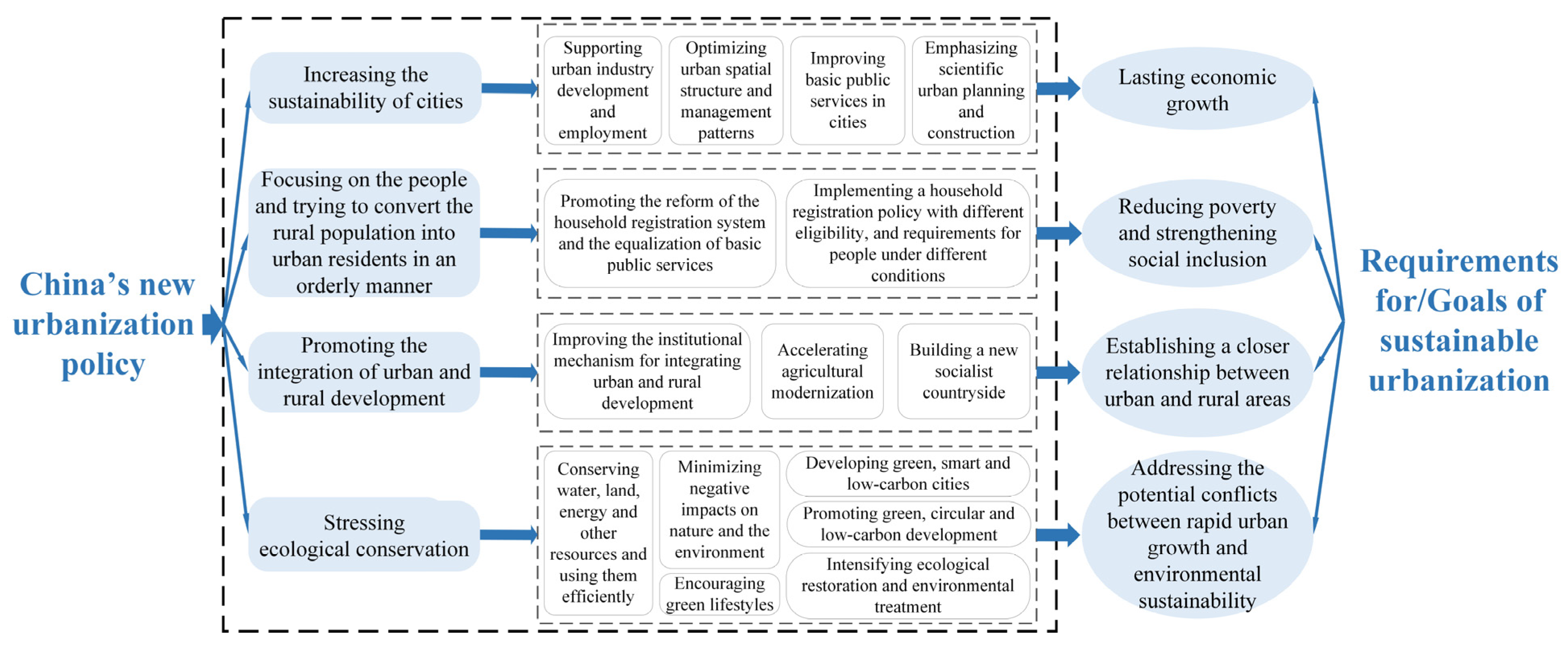
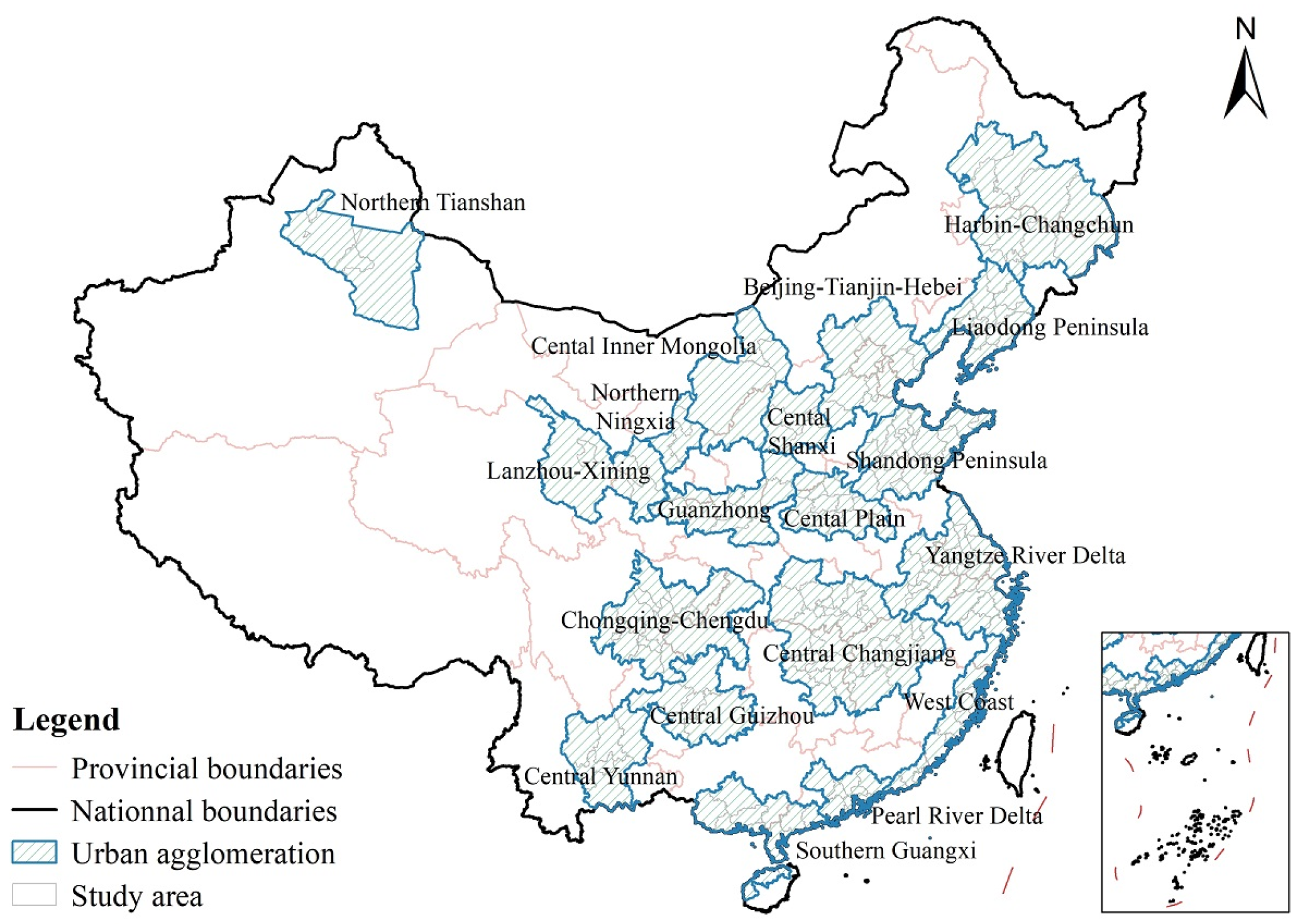
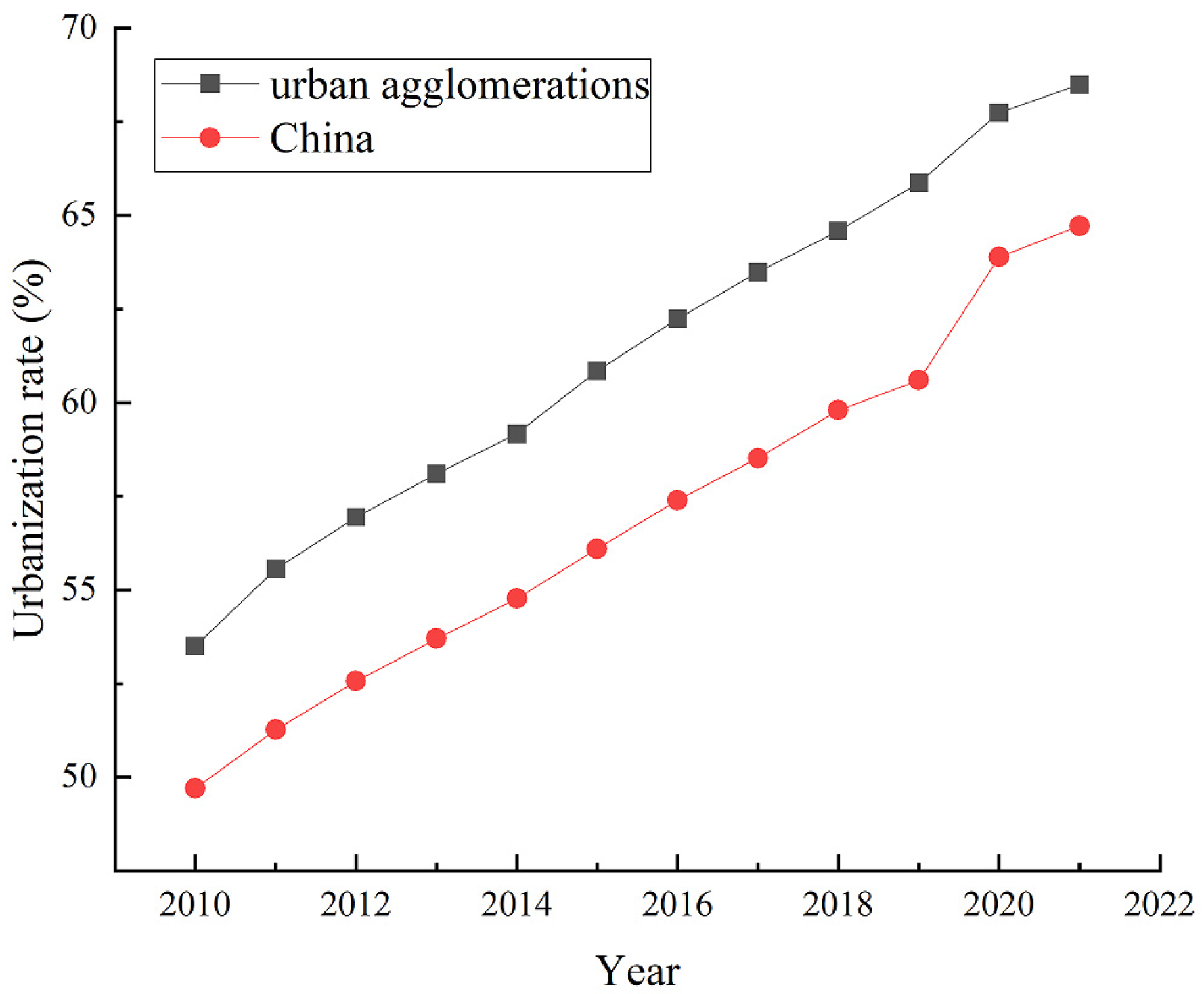
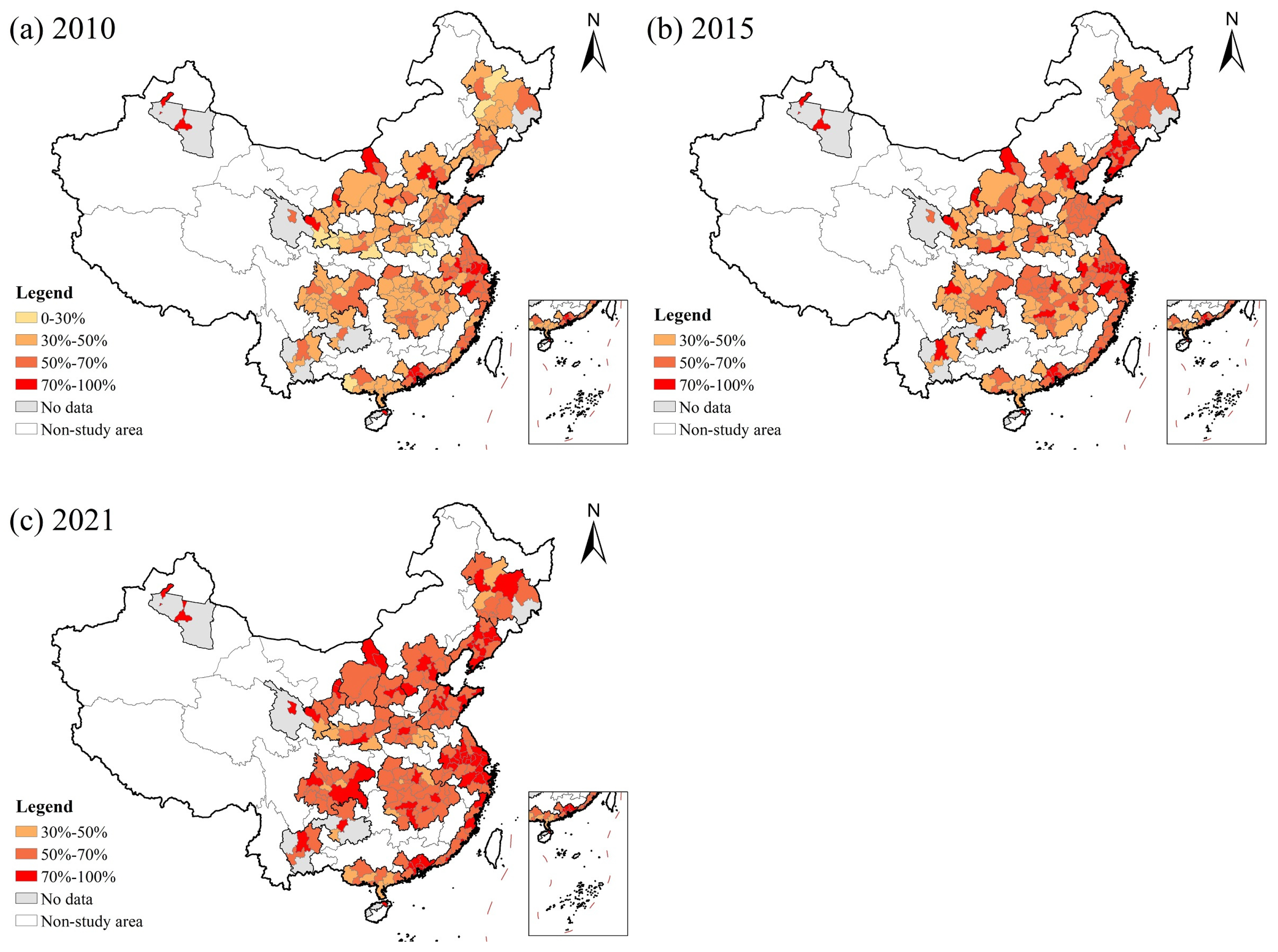
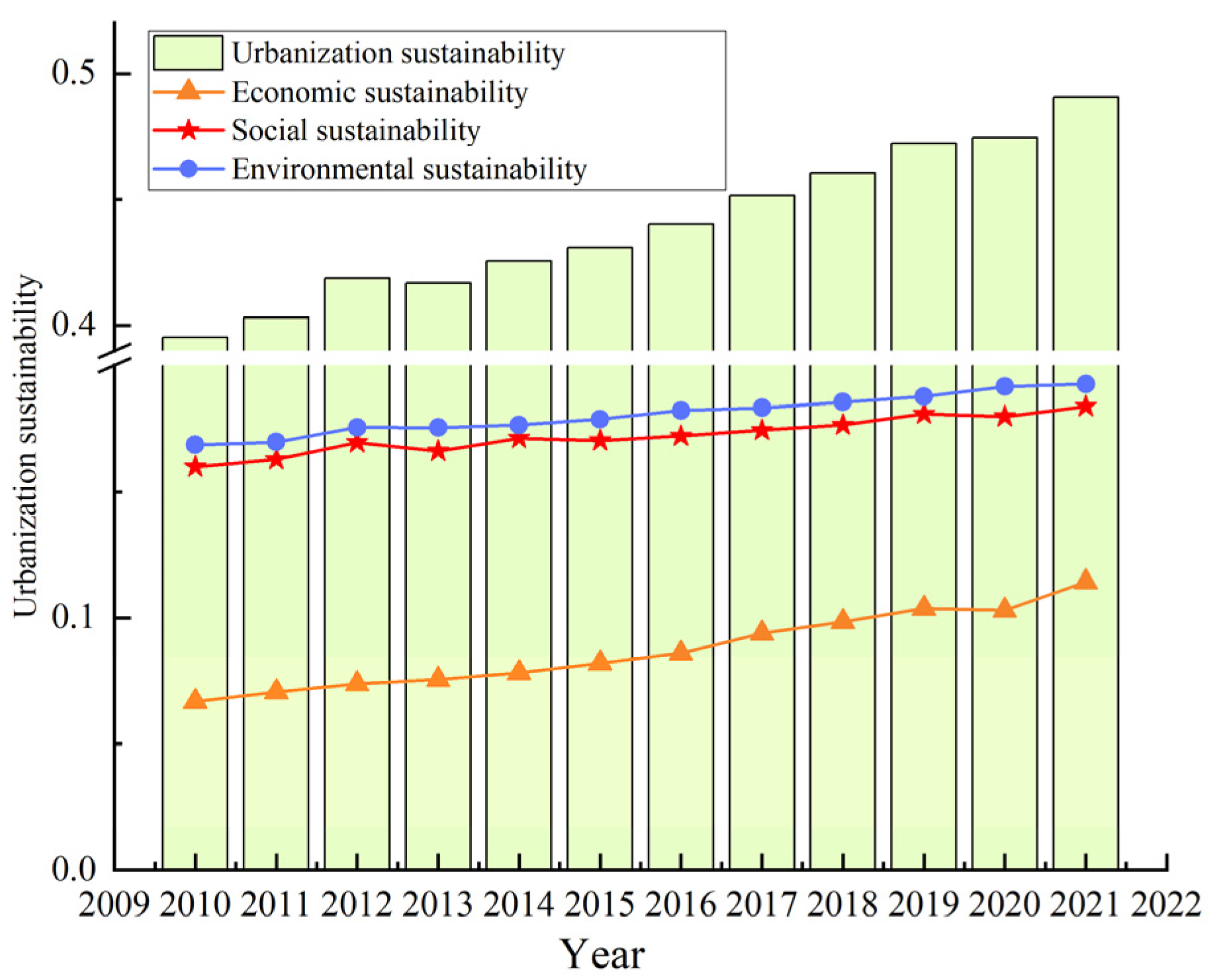
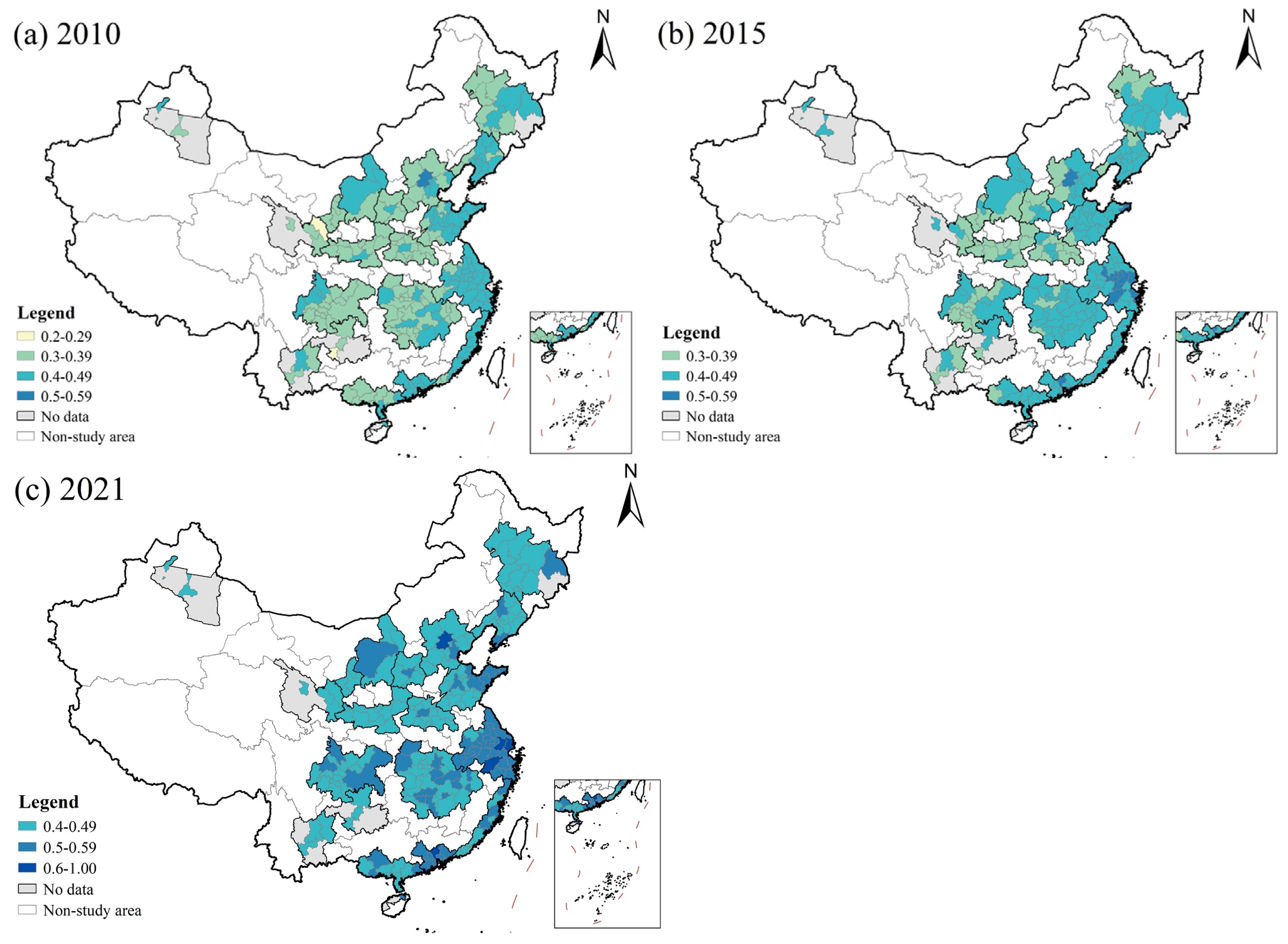



| Indicator Dimensions | Methodology/Mode | Reference |
|---|---|---|
| Socioeconomic, Environmental, Institutional Capacity, Coordination, Ecological and Environmental Potential, and Welfare Growth Potential | Elasticity coefficient; VuR–VuS coordinate. | [26] |
| Social, Economic, and Environmental | Bi-dimensional matrix model. | [27] |
| Economic, Environmental, and Social | Elastic coefficient model; McKinsey matrix model. | [28] |
| Quality of Built Environment and Environmental Pressure | Spatio-temporal coupling coordinated development (CCD) model. | [29] |
| Urbanization, Resources, and Environmental | Coordinated development index. | [30] |
| Environmental | Ecological footprint and biocapacity. | [31] |
| Environmental and Social | Human development; index and ecological footprint. | [32] |
| Ecological | Combination of spatial assessment of ecosystem services’ demand and nature-based solutions. | [33] |
| Ecological | Ecological capacity. | [34] |
| S1: Esu > 1 with ∆ur > 0 & ∆us > 0 | S2: Esu > 1 with ∆ur < 0 & ∆us < 0 | S3: Esu = 1 with ∆ur = ∆us > 0 | S4: Esu = 1 with ∆ur = ∆us < 0 |
| This scenario suggests a sustainable urbanization status where us increases at a faster rate than ur. | This scenario suggests an unsustainable urbanization status, with us decreasing at a faster rate than ur. | This scenario suggests a sustainable urbanization status, with both ur and us increasing at the same rate. | This scenario suggests an unsustainable urbanization status where both ur and us are decreasing at the same rate. |
| S5: 1 > Esu > 0 with ∆ur > 0 & ∆us > 0 | S6: 1 > Esu > 0 with ∆ur < 0 & ∆us < 0 | S7: Esu < 0 with ∆ur > 0 & ∆us < 0 | S8: Esu < 0 with ∆ur < 0 & ∆us > 0 |
| This scenario suggests an unsustainable urbanization status, with ur increasing at a faster rate than us. | This scenario suggests an unsustainable urbanization status where us is decreasing at a faster rate than ur. | This scenario suggests an unsustainable urbanization status, with ur increasing while us decreases. | This scenario suggests a sustainable status, with ur decreasing and us increasing. |
| Dimension | Indicator [Code] | Unit | Type | Description/Measure | Weight | Source |
|---|---|---|---|---|---|---|
| Economy | GDP per capita (S1) | CNY | + | GDP/population | 0.0333 | Statistical Yearbook of Chinese Cities |
| Growth rate of GDP per year (S2) | % | + | (GDPt2 − GDPt1)/GDPt1 | 0.0333 | Statistical Yearbook of Chinese Cities | |
| Social labor productivity (S3) | CNY/person | + | GDP/population | 0.0667 | Statistical Yearbook of Chinese Cities | |
| Ratio of added value of the tertiary industry to the GDP (S4) | % | + | Added value of the tertiary industry/GDP | 0.0333 | Statistical Yearbook of Chinese Cities | |
| Per capita retail sales of consumer goods (S5) | CNY | + | Total retail sales of consumer goods/population | 0.0333 | Statistical Yearbook of Chinese Cities | |
| Per capita disposable income (S6) | CNY | + | Disposable income per capita = urban residents’ disposable income per capita× ratio of urban population + rural residents’ disposable income per capita × ratio of rural population | 0.0667 | Statistical Yearbook of Chinese Cities | |
| Ratio of fiscal expenditure on science and technology to GDP (S7) | % | + | Fiscal expenditure on science and technology/GDP | 0.0333 | Statistical yearbooks and statistical bulletins of all the provinces and regions of China | |
| Number of patents granted (S8) | Unit | + | Number of patents granted by patent administration during the study period | 0.0333 | Statistical yearbooks and statistical bulletins of all the provinces and regions of China | |
| Society | City-registered unemployment rate (S9) | % | - | Ratio of urban-registered unemployed persons to the total number of urban employees and the urban-registered unemployed persons at the end of the study period. | 0.0556 | Statistical Yearbook of Chinese Cities |
| Social insurance coverage rate (S10) | % | + | Urban workers’ basic pension insurance participants/city population × 50% + workers’ basic medical insurance participants/city population × 50% | 0.0556 | Statistical Yearbook of Chinese Cities | |
| Income ratio between city and rural residents (S11) | % | - | Per capita disposable income of urban residents/per capita net income of rural residents | 0.0556 | Statistical Yearbook of Chinese Cities | |
| Ratio of teachers to students in primary and middle schools (S12) | % | + | Number of teachers/students in primary and middle schools | 0.0278 | Statistical Yearbook of Chinese Cities | |
| Number of college students per 1000,000 population (S13) | person | + | Number of college students/population | 0.0278 | Statistical Yearbook of Chinese Cities | |
| Life expectancy (S14) | year | + | An estimate of the average number of years a person of a given age can expect to live | 0.0278 | Report on the development of Chinese people | |
| Number of licensed doctors per 10,000 population (S15) | person | + | Number of licensed doctors/population | 0.0278 | Statistical Yearbook of Chinese Cities | |
| Water coverage rate (S16) | % | + | Ratio of population using water to total population in urban areas | 0.0278 | Statistical Yearbook of Urban Construction in China | |
| Gas coverage rate (S17) | % | + | Ratio of the population using gas to the total population in urban areas | 0.0278 | Statistical Yearbook of Urban Construction in China | |
| Water consumption per unit GDP (S18) | Ton/CNY | - | Total water consumption/GDP | 0.0278 | Bulletin of water resources’ statistics of all the provinces and regions of China | |
| Environment | Industrial sulfur dioxide emissions per unit of GDP (S19) | Ton/CNY | - | Total SO2 emissions/GDP | 0.0278 | Statistical Yearbook of Chinese Cities |
| Electricity consumption per unit of GDP (S20) | 10000kwh/CNY | - | Electricity consumption/GDP | 0.0278 | Statistical Yearbook of Chinese Cities | |
| Annual mean concentration of PM2.5 (S21) | (ug/m3) | - | The arithmetic mean of the average PM2.5 concentration for each day of the year. | 0.0278 | Statistical yearbooks and statistical bulletins of all the provinces and regions of China | |
| Centralized treatment rate of wastewater treatment plants (S22) | % | + | Volume of sewage treated/total volume of sewage discharged × 100% | 0.0278 | Statistical Yearbook of Urban Construction in China | |
| Domestic garbage harmless treatment rate (S23) | % | + | Domestic garbage harmless treatment/domestic waste generated | 0.0278 | Statistical Yearbook of Urban Construction in China | |
| Ratio of industrial solid waste comprehensively utilized (S24) | % | + | Industrial solid waste comprehensively utilized/general industrial solid waste generation | 0.0278 | Statistical Yearbook of Urban Construction in China | |
| Ratio of fiscal expenditure on environmental protection to GDP (S25) | % | + | Fiscal expenditure on environmental protection/GDP | 0.0278 | Fiscal revenue and expenditure bulletins and statistical yearbooks of all the provinces and regions of China | |
| Per capita green area (S26) | m2 | + | Green area of urban parks/urban population + urban transient population | 0.0556 | Statistical Yearbook of Urban Construction in China | |
| Per capita water resources (S27) | cubic meters/person | + | Water resources/population | 0.0556 | Bulletin of water resources’ statistics of all the provinces and regions of China |
| Development Stage | Urban Agglomerations | 2010 | 2011 | 2012 | 2013 | 2014 | 2015 | 2016 | 2017 | 2018 | 2019 | 2020 | 2021 |
|---|---|---|---|---|---|---|---|---|---|---|---|---|---|
| Mature stage | Pearl River Delta | 0.4638 | 0.4699 | 0.4912 | 0.4924 | 0.4906 | 0.4995 | 0.5064 | 0.5173 | 0.5241 | 0.5339 | 0.5295 | 0.5469 |
| Yangze River Delta | 0.4286 | 0.4358 | 0.4556 | 0.4547 | 0.4672 | 0.4796 | 0.4911 | 0.5013 | 0.5118 | 0.5268 | 0.5348 | 0.5535 | |
| Beijing–Tianjing–Hebei | 0.4016 | 0.4093 | 0.4172 | 0.4141 | 0.4208 | 0.4301 | 0.4397 | 0.4596 | 0.4674 | 0.4731 | 0.4770 | 0.4913 | |
| Late growth stage | Shandong Peninsula | 0.4163 | 0.4277 | 0.4407 | 0.4402 | 0.4551 | 0.4511 | 0.4636 | 0.4700 | 0.4774 | 0.4822 | 0.4854 | 0.5044 |
| West Coast | 0.4125 | 0.4217 | 0.4393 | 0.4333 | 0.4398 | 0.4509 | 0.4553 | 0.4602 | 0.4684 | 0.4864 | 0.4860 | 0.4958 | |
| Liaodong Peninsula | 0.4179 | 0.4246 | 0.4406 | 0.4419 | 0.4334 | 0.4267 | 0.4239 | 0.4415 | 0.4473 | 0.4458 | 0.4479 | 0.4593 | |
| Central Changjiang | 0.3819 | 0.3884 | 0.4074 | 0.4062 | 0.4174 | 0.4267 | 0.4363 | 0.4492 | 0.4550 | 0.4706 | 0.4744 | 0.4961 | |
| Chongqing–Chengdu | 0.3741 | 0.3850 | 0.3953 | 0.3890 | 0.4026 | 0.4013 | 0.4109 | 0.4251 | 0.4395 | 0.4558 | 0.4609 | 0.4760 | |
| Early growth stage | Northern Tianshan | 0.4108 | 0.4212 | 0.4435 | 0.4415 | 0.4546 | 0.4482 | 0.4574 | 0.4625 | 0.4775 | 0.4844 | 0.5010 | 0.4976 |
| Guanzhong | 0.3514 | 0.3632 | 0.3774 | 0.3705 | 0.3767 | 0.3848 | 0.3889 | 0.4002 | 0.4035 | 0.4183 | 0.4178 | 0.4389 | |
| Central Plain | 0.3600 | 0.3617 | 0.3778 | 0.3752 | 0.3909 | 0.3966 | 0.4040 | 0.4253 | 0.4333 | 0.4490 | 0.4480 | 0.4671 | |
| Central Shanxi | 0.3779 | 0.3786 | 0.3934 | 0.3899 | 0.3963 | 0.3961 | 0.4089 | 0.4157 | 0.4283 | 0.4384 | 0.4396 | 0.4488 | |
| Harbin–Changchun | 0.3967 | 0.4003 | 0.4179 | 0.4134 | 0.4110 | 0.4099 | 0.4268 | 0.4246 | 0.4458 | 0.4544 | 0.4527 | 0.4658 | |
| Southern Guangxi | 0.3891 | 0.4004 | 0.4156 | 0.4212 | 0.4236 | 0.4303 | 0.4393 | 0.4576 | 0.4622 | 0.4713 | 0.4689 | 0.4868 | |
| Northern Ningxia | 0.3690 | 0.3666 | 0.3775 | 0.3799 | 0.3887 | 0.3903 | 0.4050 | 0.4127 | 0.4268 | 0.4426 | 0.4424 | 0.4537 | |
| Early stage | Central Yunnan | 0.3694 | 0.3699 | 0.3762 | 0.3653 | 0.3919 | 0.3909 | 0.3984 | 0.4049 | 0.4153 | 0.4375 | 0.4321 | 0.4482 |
| Lanzhou–Xining | 0.3226 | 0.3419 | 0.3592 | 0.3619 | 0.3741 | 0.3861 | 0.4023 | 0.4116 | 0.4132 | 0.4285 | 0.4273 | 0.4376 | |
| Central Inner Mongolia | 0.4098 | 0.4297 | 0.4414 | 0.4275 | 0.4436 | 0.4494 | 0.4545 | 0.4488 | 0.4611 | 0.4648 | 0.4636 | 0.4818 | |
| Central Guizhou | 0.3428 | 0.3547 | 0.3713 | 0.3859 | 0.3981 | 0.4121 | 0.4288 | 0.4376 | 0.4491 | 0.4592 | 0.4570 | 0.4503 |
| Urban Agglomerations | Esu (2010–2015) | Scenarios (2010–2015) | Esu (2015–2021) | Scenarios (2015–2021) | Esu (2010–2021) | Scenarios (2010–2021) |
|---|---|---|---|---|---|---|
| Beijing–Tianjing–Hebei | 0.4796 | S5 | 1.0408 | S1 | 0.7583 | S5 |
| Yangze River Delta | 1.1958 | S1 | 1.0181 | S1 | 1.0839 | S1 |
| Pearl River Delta | 2.1181 | S1 | 1.5495 | S1 | 1.7519 | S1 |
| Central Changjiang | 0.5845 | S5 | 0.7390 | S5 | 0.6696 | S5 |
| Chongqing–Chengdu | 0.3449 | S5 | 0.7792 | S5 | 0.5834 | S5 |
| Liaodong Peninsula | 0.0424 | S5 | 0.6361 | S5 | 0.1599 | S5 |
| Shandong Peninsula | 0.4771 | S5 | 0.7663 | S5 | 0.6182 | S5 |
| West Coast | 1.0894 | S1 | 0.8335 | S5 | 0.9347 | S5 |
| Central Plain | 0.4535 | S5 | 0.7661 | S5 | 0.6198 | S5 |
| Harbin–Changchun | 0.1027 | S5 | 1.1646 | S1 | 0.3928 | S5 |
| Guanzhong | 0.3867 | S5 | 0.5786 | S5 | 0.4863 | S5 |
| Southern Guangxi | 0.8733 | S5 | 0.6956 | S5 | 0.7609 | S5 |
| Northern Tianshan | −0.2117 | S8 | 1.7215 | S1 | −0.5859 | S8 |
| Central Shanxi | 0.2278 | S5 | 0.6825 | S5 | 0.4510 | S5 |
| Central Inner Mongolia | 0.6785 | S5 | 0.4405 | S5 | 0.5457 | S5 |
| Central Guizhou | 0.7536 | S5 | 0.3498 | S5 | 0.5344 | S5 |
| Central Yunnan | 0.2686 | S5 | 0.5626 | S5 | 0.4330 | S5 |
| Lanzhou–Xining | 1.0911 | S1 | 0.5395 | S5 | 0.7485 | S5 |
| Northern Ningxia | 0.3661 | S5 | 0.6472 | S5 | 0.5426 | S5 |
| Change in Scenarios | Number | City |
|---|---|---|
| S7→S1 | 3 | Yibin, Dandong, Chaozhou |
| S8→S1 | 1 | Shanghai |
| S5→S1 | 45 | Tangshan, Cangzhou, Changzhou, Yancheng, Taizhou, Jinhua, Maanshan, Dongguan, Jingzhou, Ezhou, Huanggang, Yichang, Tianmen, Xiangyang, Xiangtan, Hengyang, Yueyang, Yiyang, Loudi, Jingdezhen, Xinyu, Pingxiang, Chengdu, Mianyang, Meishan, Leshan, Zigong, Neijiang, Huludao, Qingdao, Binzhou, Dezhou, Linyi, Pingdingshan, Bozhou, Qiqihar, Siping, Tongchuan, Yuncheng, Beihai, Yulin, Taiyuan, Ordos, Taiyuan, Erdos, Yuxi, Shizuishan |
| S7→S5 | 6 | Baoding, Dazhou, Anshan, Tieling, Changchun, Lvliang |
| S8→S5 | 3 | Tongling, Mudanjiang, Urumqi |
| S5→S7 | 1 | Fushun |
| S5→S8 | 1 | Qianjiang |
| S1→S5 | 21 | Wuxi, Hangzhou, Ningbo, Shaoxing, Hefei, Zhaoqing, Huizhou, Wuhan, Huangshi, Xianning, Ziyang, Luzhou, Jinan, Dongying, Quanzhou, Zhanjiang, Maoming, Haikou, Guiyang, Baiyin, Xining |
Disclaimer/Publisher’s Note: The statements, opinions and data contained in all publications are solely those of the individual author(s) and contributor(s) and not of MDPI and/or the editor(s). MDPI and/or the editor(s) disclaim responsibility for any injury to people or property resulting from any ideas, methods, instructions or products referred to in the content. |
© 2024 by the authors. Licensee MDPI, Basel, Switzerland. This article is an open access article distributed under the terms and conditions of the Creative Commons Attribution (CC BY) license (https://creativecommons.org/licenses/by/4.0/).
Share and Cite
Liu, S.; Jia, L.; Zhang, F.; Wang, R.; Liu, X.; Zou, L.; Tang, X. Do New Urbanization Policies Promote Sustainable Urbanization? Evidence from China’s Urban Agglomerations. Land 2024, 13, 412. https://doi.org/10.3390/land13040412
Liu S, Jia L, Zhang F, Wang R, Liu X, Zou L, Tang X. Do New Urbanization Policies Promote Sustainable Urbanization? Evidence from China’s Urban Agglomerations. Land. 2024; 13(4):412. https://doi.org/10.3390/land13040412
Chicago/Turabian StyleLiu, Shiwei, Luyao Jia, Feng Zhang, Rutong Wang, Xian Liu, Lu Zou, and Xuguang Tang. 2024. "Do New Urbanization Policies Promote Sustainable Urbanization? Evidence from China’s Urban Agglomerations" Land 13, no. 4: 412. https://doi.org/10.3390/land13040412
APA StyleLiu, S., Jia, L., Zhang, F., Wang, R., Liu, X., Zou, L., & Tang, X. (2024). Do New Urbanization Policies Promote Sustainable Urbanization? Evidence from China’s Urban Agglomerations. Land, 13(4), 412. https://doi.org/10.3390/land13040412






